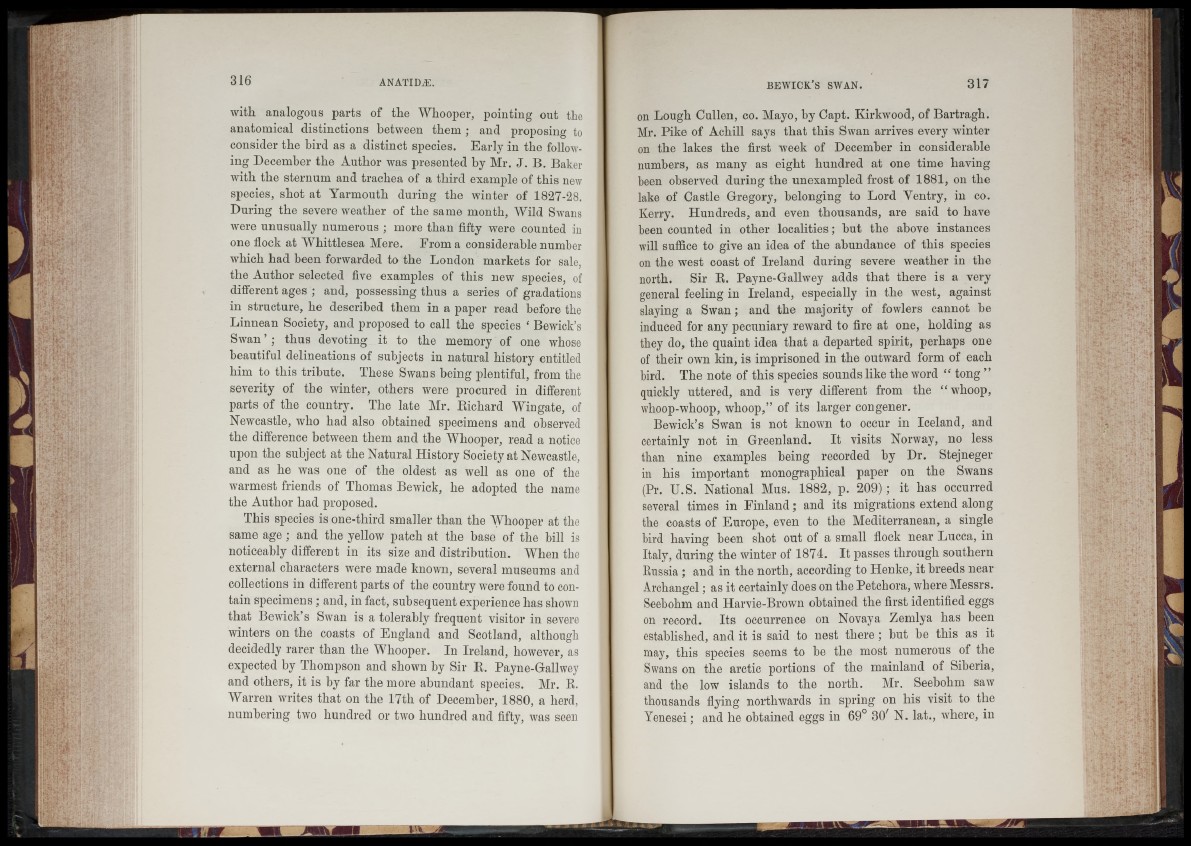
with analogous parts of the Whooper, pointing out the
anatomical distinctions between them; and proposing to
consider the bird as a distinct species. Early in the following
December the Author was presented by Mr. J. B. Baker
with the sternum and trachea of a third example of this new
species, shot at Yarmouth during the winter of 1827-28.
During the severe weather of the same month, Wild Swans
were unusually numerous ; more than fifty were counted in
one flock at Whittlesea Mere. From a considerable number
which had been forwarded to the London markets for sale,
the Author selected five examples of this new species, of
different ages ; and, possessing thus a series of gradations
in structure, he described them in a paper read before the
Linnean Society, and proposed to call the species ‘ Bewick’s
Swan ’ ; thus devoting it to the memory of one whose
beautiful delineations of subjects in natural history entitled
him to this tribute. These Swans being plentiful, from the
severity of the winter, others were procured in different
parts of the country. The late Mr. Bichard Wingate, of
Newcastle, who had also obtained specimens and observed
the difference between them and the Whooper, read a notice
upon the subject at the Natural History Society at Newcastle,
and as he was one of the oldest as well as one of the
warmest friends of Thomas Bewick, he adopted the name
the Author had proposed.
This species is one-tliird smaller than the Whooper at the
same age ; and the yellow patch at the base of the bill is
noticeably different in its size and distribution. When the
external characters were made known, several museums and
collections in different parts of the country were found to contain
specimens ; and, in fact, subsequent experience has shown
that Bewick’s Swan is a tolerably frequent visitor in severe
winters on the coasts of England and Scotland, although
decidedly rarer than the Whooper. In Ireland, however, as
expected by Thompson and shown by Sir K. Payne-Gallwey
and others, it is by far the more abundant species. Mr. B.
Warren writes that on the 17th of December, 1880, a herd,
numbering two hundred or two hundred and fifty, was seen
on Lough Cullen, co. Mayo, by Capt. Kirkwood, of Bartragh.
Mr. Pike of Achill says that this Swan arrives every winter
on the lakes the first week of December in considerable
numbers, as many as eight hundred at one time having
been observed during the unexampled frost of 1881, on the
lake of Castle Gregory, belonging to Lord Yentry, in co.
Kerry. Hundreds, and even thousands, are said to have
been counted in other localities; but the above instances
will suffice to give an idea of the abundance of this species
on the west coast of Ireland during severe weather in the
north. Sir B. Payne-Gallwey adds that there is a very
general feeling in Ireland, especially in the west, against
slaying a Swan; and the majority of fowlers cannot be
induced for any pecuniary reward to fire at one, holding as
they do, the quaint idea that a departed spirit, perhaps one
of their own kin, is imprisoned in the outward form of each
bird. The note of this species sounds like the word “ tong ”
quickly uttered, and is very different from the “ whoop,
whoop-wlioop, whoop,” of its larger congener.
Bewick’s Swan is not known to occur in Iceland, and
certainly not in Greenland. It visits Norway, no less
than nine examples being recorded by Dr. Stejneger
in his important monographical paper on the Swans
(Pr. U.S. National Mus. 1882, p. 209); it has occurred
several times in Finland; and its migrations extend along
the coasts of Europe, even to the Mediterranean, a single
bird having been shot out of a small flock near Lucca, in
Italy, during the winter of 1874. It passes through southern
Russia ; and in the north, according to Henke, it breeds near
Archangel; as it certainly does on the Petchora, where Messrs.
Seebohm and Harvie-Brown obtained the first identified eggs
on record. Its occurrence on Novaya Zemlya has been
established, and it is said to nest there; but be this as it
may, this species seems to be the most numerous of the
Swans on the arctic portions of the mainland of Siberia,
and the low islands to the north. Mr. Seebohm saw
thousands flying northwards in spring on his visit to the
Yenesei; and he obtained eggs in 69° 8(/ N. lat., where, in